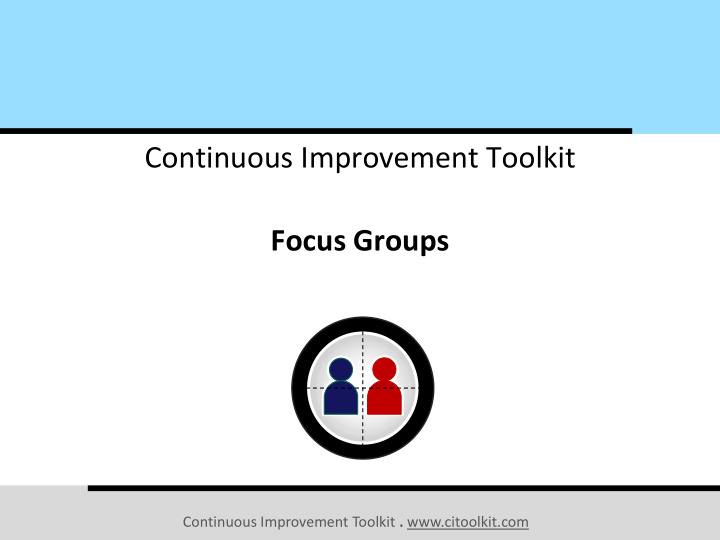



Continuous Improvement Toolkit Focus Groups Continuous Improvement Toolkit . www.citoolkit.com
The Continuous Improvement Map Managing Deciding & Selecting Planning & Project Management* Risk PDPC Decision Balance Sheet Importance-Urgency Mapping Daily Planning PERT/CPM RAID Log* Force Field Analysis Cost Benefit Analysis FMEA MOST RACI Matrix Activity Networks Break-even Analysis Voting TPN Analysis Risk Assessment* SWOT Analysis Stakeholder Analysis Decision Tree Pick Chart Four Field Matrix Fault Tree Analysis Project Charter Improvement Roadmaps Critical-to Tree QFD Portfolio Matrix Traffic Light Assessment PDCA Policy Deployment Gantt Charts DMAIC Paired Comparison Matrix Diagram Kano Analysis Lean Measures Kaizen Events Control Planning Prioritization Matrix Pugh Matrix Cost of Quality* Bottleneck Analysis** A3 Thinking Standard work Document control C&E Matrix Pareto Analysis OEE KPIs Implementing Cross Training Understanding Process Yield ANOVA Chi-Square Descriptive Statistics Solutions** Cause & Effect Value Analysis Capability Indices Probability Distributions Hypothesis Testing Ergonomics Mistake Proofing Design of Experiment Gap Analysis* Multi vari Studies Histograms & Boxplots Automation Simulation TPM Confidence Intervals Reliability Analysis Graphical Analysis Scatter Plots Pull Flow Just in Time Correlation Regression Understanding MSA 5 Whys Run Charts Visual Management 5S Root Cause Analysis Performance Data Snooping Control Charts Quick Changeover Fishbone Diagram Tree Diagram* Waste Analysis Benchmarking** SIPOC* Time Value Map Sampling Morphological Analysis Process Redesign Data collection planner* How-How Diagram** Value Stream Mapping Brainstorming Spaghetti Diagram Check Sheets SCAMPER** Attribute Analysis Interviews Service Blueprints Flow Process Charts Affinity Diagram Questionnaires Relationship Mapping* Focus Groups Data Flowcharting IDEF0 Process Mapping Mind Mapping* Lateral Thinking Observations Collection Creating Ideas Designing & Analyzing Processes Suggestion systems Continuous Improvement Toolkit . www.citoolkit.com
- Focus Groups Focus Groups: A meeting that is conducted to obtain feedback on a particular topic from the point of view of a targeted participants. A type of interview made to a homogeneous group of people Aims to collect perception, opinions, feelings, ideas, and attitudes towards something. Provides an opportunity to: • Share ideas. • Obtain qualitative feedback through open questions and group dialogue. Continuous Improvement Toolkit . www.citoolkit.com
- Focus Groups Typical Applications: In marketing research studies to acquire more knowledge about customers and markets. In project management and improvement initiatives to collect information from experts relevant to the subject matter. • For example, a focus group can be used to design questionnaires before conducting a survey. Continuous Improvement Toolkit . www.citoolkit.com
- Focus Groups In the World of Marketing: Focus groups are seen as a reliable research tool to gather information on existing products or services. They help: • Understanding and prioritizing customer expectations and need. • Gaining insights into the satisfaction concerns. • Verifying perceptions of a product or service. They are also used to acquire feedback on new products, services or concepts. They allow observing people interacting with a physical product or a prototype. Continuous Improvement Toolkit . www.citoolkit.com
- Focus Groups Focus groups can be undertaken through different media: • Face-to-face meetings. • Online focus group. • Teleconference focus group. Continuous Improvement Toolkit . www.citoolkit.com
- Focus Groups How to Conduct a Focus Group: Define the objectives of the focus group. Decide who should moderator the focus group to facilitate the discussion. Select the participants based of their relevance and potential contribution. Prepare the outline and the list of questions. Invite the participants by mail at least two weeks prior the meeting. A follow-up call is required to confirm attendance two days prior the meeting. Continuous Improvement Toolkit . www.citoolkit.com
- Focus Groups How to Conduct a Focus Group: Conduct the focus group: • Start by stating your objectives. • Ask questions in an interactive way where participants are free to talk with other group members. • Allow everyone to respond to every question asked. • Record important ideas and observed conversation patterns. • Before completing, ask the participants for additional input or comments. Process then analyze the data. Continuous Improvement Toolkit . www.citoolkit.com
- Focus Groups Further Information: It is important that the facilitator acts as a neutral person and support freedom of speech. Affinity diagrams are often used to find themes in the comments of participants. Continuous Improvement Toolkit . www.citoolkit.com
Recommend
More recommend